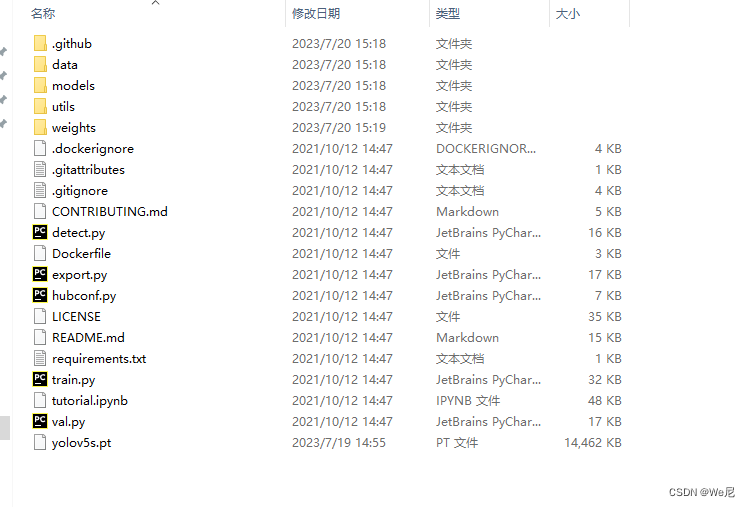- 下载YOLOv5源码:YOLOv5源码
- 下载权重文件:权重文件,放到yolov5的根目录下(都在GitHub,下载的慢的可找我要)

python export.py --weights yolov5s.pt --include onnx
- onnx模型推理(在原文的基础上修改了一些内容)--可能会出现SyntaxError:encoding problem:gbk(utf-8)的报错,把中文注释删掉就好或者删除第一行的注释
#encoding=gbk
import os
import cv2
import numpy as np
import onnxruntime
import time
CLASSES = ['person', 'bicycle', 'car', 'motorcycle', 'airplane', 'bus', 'train', 'truck', 'boat', 'traffic light',
'fire hydrant', 'stop sign', 'parking meter', 'bench', 'bird', 'cat', 'dog', 'horse', 'sheep', 'cow',
'elephant', 'bear', 'zebra', 'giraffe', 'backpack', 'umbrella', 'handbag', 'tie', 'suitcase', 'frisbee',
'skis', 'snowboard', 'sports ball', 'kite', 'baseball bat', 'baseball glove', 'skateboard', 'surfboard',
'tennis racket', 'bottle', 'wine glass', 'cup', 'fork', 'knife', 'spoon', 'bowl', 'banana', 'apple',
'sandwich', 'orange', 'broccoli', 'carrot', 'hot dog', 'pizza', 'donut', 'cake', 'chair', 'couch',
'potted plant', 'bed', 'dining table', 'toilet', 'tv', 'laptop', 'mouse', 'remote', 'keyboard', 'cell phone',
'microwave', 'oven', 'toaster', 'sink', 'refrigerator', 'book', 'clock', 'vase', 'scissors', 'teddy bear',
'hair drier', 'toothbrush'] # coco80类别
class YOLOV5():
def __init__(self, onnxpath):
self.onnx_session = onnxruntime.InferenceSession(onnxpath, providers=['CPUExecutionProvider'])
self.input_name = self.get_input_name()
self.output_name = self.get_output_name()
# -------------------------------------------------------
# 获取输入输出的名字
# -------------------------------------------------------
def get_input_name(self):
input_name = []
for node in self.onnx_session.get_inputs():
input_name.append(node.name)
return input_name
def get_output_name(self):
output_name = []
for node in self.onnx_session.get_outputs():
output_name.append(node.name)
return output_name
# -------------------------------------------------------
# 输入图像
# -------------------------------------------------------
def get_input_feed(self, img_tensor):
input_feed = {}
for name in self.input_name:
input_feed[name] = img_tensor
return input_feed
# -------------------------------------------------------
# 1.cv2读取图像并resize
# 2.图像转BGR2RGB和HWC2CHW
# 3.图像归一化
# 4.图像增加维度
# 5.onnx_session 推理
# -------------------------------------------------------
def inference(self, img_path):
img = cv2.imread(img_path)
img_o=img.copy()
or_img = cv2.resize(img, (640, 640))
img = or_img[:, :, ::-1].transpose(2, 0, 1) # BGR2RGB和HWC2CHW
img = img.astype(dtype=np.float32)
img /= 255.0
img = np.expand_dims(img, axis=0)
input_feed = self.get_input_feed(img)
pred = self.onnx_session.run(None, input_feed)[0]
return pred, img_o
# dets: array [x,6] 6个值分别为x1,y1,x2,y2,score,class
# thresh: 阈值
def nms(dets, thresh):
x1 = dets[:, 0]
y1 = dets[:, 1]
x2 = dets[:, 2]
y2 = dets[:, 3]
# -------------------------------------------------------
# 计算框的面积
# 置信度从大到小排序
# -------------------------------------------------------
areas = (y2 - y1 + 1) * (x2 - x1 + 1)
scores = dets[:, 4]
keep = []
index = scores.argsort()[::-1]
while index.size > 0:
i = index[0]
keep.append(i)
# -------------------------------------------------------
# 计算相交面积
# 1.相交
# 2.不相交
# -------------------------------------------------------
x11 = np.maximum(x1[i], x1[index[1:]])
y11 = np.maximum(y1[i], y1[index[1:]])
x22 = np.minimum(x2[i], x2[index[1:]])
y22 = np.minimum(y2[i], y2[index[1:]])
w = np.maximum(0, x22 - x11 + 1)
h = np.maximum(0, y22 - y11 + 1)
overlaps = w * h
# -------------------------------------------------------
# 计算该框与其它框的IOU,去除掉重复的框,即IOU值大的框
# IOU小于thresh的框保留下来
# -------------------------------------------------------
ious = overlaps / (areas[i] + areas[index[1:]] - overlaps)
idx = np.where(ious <= thresh)[0]
index = index[idx + 1]
return keep
def xywh2xyxy(x):
# [x, y, w, h] to [x1, y1, x2, y2]
y = np.copy(x)
y[:, 0] = x[:, 0] - x[:, 2] / 2
y[:, 1] = x[:, 1] - x[:, 3] / 2
y[:, 2] = x[:, 0] + x[:, 2] / 2
y[:, 3] = x[:, 1] + x[:, 3] / 2
return y
def filter_box(org_box, conf_thres, iou_thres): # 过滤掉无用的框
# -------------------------------------------------------
# 删除为1的维度
# 删除置信度小于conf_thres的BOX
# -------------------------------------------------------
org_box = np.squeeze(org_box)
conf = org_box[..., 4] > conf_thres
box = org_box[conf == True]
# -------------------------------------------------------
# 通过argmax获取置信度最大的类别
# -------------------------------------------------------
cls_cinf = box[..., 5:]
cls = []
for i in range(len(cls_cinf)):
cls.append(int(np.argmax(cls_cinf[i])))
all_cls = list(set(cls))
# -------------------------------------------------------
# 分别对每个类别进行过滤
# 1.将第6列元素替换为类别下标
# 2.xywh2xyxy 坐标转换
# 3.经过非极大抑制后输出的BOX下标
# 4.利用下标取出非极大抑制后的BOX
# -------------------------------------------------------
output = []
for i in range(len(all_cls)):
curr_cls = all_cls[i]
curr_cls_box = []
curr_out_box = []
for j in range(len(cls)):
if cls[j] == curr_cls:
box[j][5] = curr_cls
curr_cls_box.append(box[j][:6])
curr_cls_box = np.array(curr_cls_box)
# curr_cls_box_old = np.copy(curr_cls_box)
curr_cls_box = xywh2xyxy(curr_cls_box)
curr_out_box = nms(curr_cls_box, iou_thres)
for k in curr_out_box:
output.append(curr_cls_box[k])
output = np.array(output)
return output
def draw(image, box_data):
# -------------------------------------------------------
# 取整,方便画框
# -------------------------------------------------------
boxes = box_data[..., :4].astype(np.int32)
scores = box_data[..., 4]
classes = box_data[..., 5].astype(np.int32)
img_height_o=image.shape[0]
img_width_o=image.shape[1]
x_ratio=img_width_o/640
y_ratio=img_height_o/640
for box, score, cl in zip(boxes, scores, classes):
top, left, right, bottom = box
print('class: {}, score: {}'.format(CLASSES[cl], score))
print('box coordinate left,top,right,down: [{}, {}, {}, {}]'.format(top, left, right, bottom))
top=int(top*x_ratio)
right=int(right*x_ratio)
left=int(left*y_ratio)
bottom=int(bottom*y_ratio)
cv2.rectangle(image, (top, left), (right, bottom), (255, 0, 0), 2)
cv2.putText(image, '{0} {1:.2f}'.format(CLASSES[cl], score),
(top, left),
cv2.FONT_HERSHEY_SIMPLEX,
0.6, (0, 0, 255), 2)
if __name__ == "__main__":
onnx_path = 'yolov5s.onnx'
model = YOLOV5(onnx_path) #模型的输出85组成:x、y、w、h、前景得分、80个类别
output, or_img = model.inference('Image00003.jpg')
outbox = filter_box(output, 0.5, 0.5)
draw(or_img, outbox)
cv2.imwrite('res.jpg', or_img)























 3147
3147











 被折叠的 条评论
为什么被折叠?
被折叠的 条评论
为什么被折叠?








